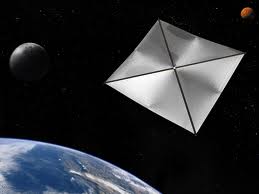Next year, NASA is set to unfurl a solar sail which could transform our ability to travel in space.
Sunjammer measures 124 feet on a side and has a total surface area of 13,000 square feet – about a third of an acre. When it’s rolled up it weighs just 70 pounds.
NASA’s intention is to demonstrate the value of "propellantless propulsion," using only photons from the sun as a fuel source. For now, Sunjammer will demonstrate the technology, but in the future it will likely be used in missions to near-Earth asteroids, to remove orbital debris and spent satellites and to travel outside our solar system.
The biggest risk is during deployment, in unfurling the sail. A camera attached to the sail will capture the unfurling process.
It’s being built by L’Garde Inc. of Tustin, California, which has already developed inflatable structures for NASA, such as solar arrays.
It will be catapulted into space by a SpaceX rocket, the company owned by Tesla CEO Elon Musk.

"With this sail, we’re targeting our end goal somewhere in the neighborhood of 1,864,114 miles (3 million kilometers) distance from the Earth," Nathan Barnes of L’Garde told Space.com.
In 2010, NASA launched a small solar sail of 100 square feet (NanoSail-D), and Japan also deployed a solar sail that year, making its Ikaros probe the first craft to cruise through space propelled only by sunlight.
"All space travel right now is limited by expendables," Billy Derbes, chief engineer for Sunjammer, told Space.com. "If you show a technology not limited by expendables – and Kapton (the material the solar sail is constructed from) is a long-lasting film material – what new applications will people think up? We’re opening up a whole new kind of thinking about how you do things in space."
"I’m most excited about using a solar sail unfurled close to the sun, inside the orbit of Mercury, and using the increased solar pressure there to accelerate a large solar sail to speeds that will allow it to reach well beyond the edge of the solar system and into interstellar space within my lifetime," Les Johnson of NASA told Space.com.
That would be "the first ‘baby step’ in a series of increasingly large sails that might one day enable us to reach the stars. This is one of the few ways nature has provided for us to travel between the stars," he says.
